A New Method for the Rapid Determination of Fire Disturbance Events Using GEE and the VCT Algorithm—A Case Study in Southwestern and Northeastern China
Abstract
1. Introduction
2. Study Area and Data
2.1. Study Area
2.2. Data and Preprocessing
2.2.1. Landsat Images and Preprocessing
2.2.2. Forest Disturbance Patch Data
3. Method
3.1. Mapping Forest Disturbance Events with the VCT Algorithm
3.2. Vegetation Index Calculation and Normalization
3.2.1. Vegetation Index Calculations
3.2.2. Vegetation Index Standardization
3.3. Detection of the Disturbance Time and Type
3.3.1. Calculation of Differenced Vegetation Indices
3.3.2. Decision Tree Construction
3.3.3. Disturbance Occurrence Time Determination and Type Classification
3.4. Accuracy Verification
3.4.1. Accuracy Verification of the Disturbance Occurrence Time
3.4.2. Classification Accuracy of Disturbance Type
3.5. Flowchart
4. Results
4.1. VCT-Mapped Forest Disturbance Events
4.2. Vegetation Index Standardization
4.3. Identification of Forest Disturbance Events and Accuracy Assessment
4.4. Fire Disturbance Type Extraction Results and Accuracy Validation
5. Discussion
5.1. Determining the Occurrence of Disturbances Using All Available Images
5.2. Extraction of Fire Disturbance Events
6. Conclusions
Author Contributions
Funding
Institutional Review Board Statement
Informed Consent Statement
Data Availability Statement
Conflicts of Interest
References
- Liu, N.; Wang, D.; Guo, Q. Exploring the Influence of Large Trees on Temperate Forest Spatial Structure from the Angle of Mingling. For. Ecol. Manag. 2021, 492, 119220. [Google Scholar] [CrossRef]
- Nunery, J.S.; Keeton, W.S. Forest Carbon Storage in the Northeastern United States: Net Effects of Harvesting Frequency, Post-Harvest Retention, and Wood Products. For. Ecol. Manag. 2010, 259, 1363–1375. [Google Scholar] [CrossRef]
- He, L.; Ivanov, V.Y.; Bohrer, G.; Thomsen, J.E.; Vogel, C.S.; Moghaddam, M. Temporal Dynamics of Soil Moisture in a Northern Temperate Mixed Successional Forest after a Prescribed Intermediate Disturbance. Agric. For. Meteorol. 2013, 180, 22–33. [Google Scholar] [CrossRef]
- Eshleman, K.N.; McNeil, B.E.; Townsend, P.A. Validation of a Remote Sensing Based Index of Forest Disturbance Using Streamwater Nitrogen Data. Ecol. Indic. 2009, 9, 476–484. [Google Scholar] [CrossRef]
- Elmqvist, T.; Wall, M.; Berggren, A.L.; Blix, L.; Fritioff, Å.; Rinman, U. Tropical Forest Reorganization after Cyclone and Fire Disturbance in Samoa: Remnant Trees as Biological Legacies. Ecol. Soc. 2002, 5, 213–218. [Google Scholar] [CrossRef]
- Huang, C.; Goward, S.N.; Masek, J.G.; Thomas, N.; Zhu, Z.; Vogelmann, J.E. An Automated Approach for Reconstructing Recent Forest Disturbance History Using Dense Landsat Time Series Stacks. Remote Sens. Environ. 2010, 114, 183–198. [Google Scholar] [CrossRef]
- Heinselman, M.L. Fire in the Virgin Forests of the Boundary Waters Canoe Area, Minnesota. Quat. Res. 1973, 3, 329–382. [Google Scholar] [CrossRef]
- Bergeron, Y. The Influence of Island and Mainland Lakeshore Landscapes on Boreal Forest Fire Regimes. Ecology 1991, 72, 1980–1992. [Google Scholar] [CrossRef]
- Cao, G. Application of Remote Sensing Technology in Forest Resources Investigation. Remote Sens. 2020, 9, 46. [Google Scholar] [CrossRef]
- Herold, M.; Roberts, D.A.; Gardner, M.E.; Dennison, P.E. Spectrometry for Urban Area Remote Sensing–Development and Analysis of a Spectral Library from 350 to 2400 Nm. Remote Sens. Environ. 2004, 91, 304–319. [Google Scholar] [CrossRef]
- Martinuzzi, S.; Gould, W.A.; Ramos González, O.M. Land Development, Land Use, and Urban Sprawl in Puerto Rico Integrating Remote Sensing and Population Census Data. Landsc. Urban Plan. 2007, 79, 288–297. [Google Scholar] [CrossRef]
- Yang, X.J.; Chang, Z.M.; Zhou, H.; Qu, X.; Li, C.J. Services for Parallel Remote-Sensing Image Processing Based on Computational Grid. Lect. Notes Comput. Sci. 2004, 3252, 689–696. [Google Scholar] [CrossRef]
- Mas, J.F. Monitoring Land-Cover Changes: A Comparison of Change Detection Techniques. Int. J. Remote Sens. 1999, 20, 139–152. [Google Scholar] [CrossRef]
- Hua, J.; Chen, G.; Yu, L.; Ye, Q.; Jiao, H.; Luo, X. Improved Mapping of Long-Term Forest Disturbance and Recovery Dynamics in the Subtropical China Using All Available Landsat Time-Series Imagery on Google Earth Engine Platform. IEEE J. Sel. Top. Appl. Earth Obs. Remote Sens. 2021, 14, 2754–2768. [Google Scholar] [CrossRef]
- Huang, C.; Thomas, N.; Goward, S.N.; Masek, J.G.; Zhu, Z.; Townshend, J.R.G.; Vogelmann, J.E. Automated Masking of Cloud and Cloud Shadow for Forest Change Analysis Using Landsat Images. Int. J. Remote Sens. 2010, 31, 5449–5464. [Google Scholar] [CrossRef]
- Gorelick, N.; Hancher, M.; Dixon, M.; Ilyushchenko, S.; Thau, D.; Moore, R. Google Earth Engine: Planetary-Scale Geospatial Analysis for Everyone. Remote Sens. Environ. 2017, 202, 18–27. [Google Scholar] [CrossRef]
- Weng, Q.; Fu, P.; Gao, F. Generating Daily Land Surface Temperature at Landsat Resolution by Fusing Landsat and MODIS Data. Remote Sens. Environ. 2014, 145, 55–67. [Google Scholar] [CrossRef]
- Kennedy, R.E.; Yang, Z.; Cohen, W.B. Detecting Trends in Forest Disturbance and Recovery Using Yearly Landsat Time Series: 1. LandTrendr-Temporal Segmentation Algorithms. Remote Sens. Environ. 2010, 114, 2897–2910. [Google Scholar] [CrossRef]
- Zhu, Z.; Woodcock, C.E. Continuous Change Detection and Classification of Land Cover Using All Available Landsat Data. Remote Sens. Environ. 2014, 144, 152–171. [Google Scholar] [CrossRef]
- DeVries, B.; Verbesselt, J.; Kooistra, L.; Herold, M. Robust Monitoring of Small-Scale Forest Disturbances in a Tropical Montane Forest Using Landsat Time Series. Remote Sens. Environ. 2015, 161, 107–121. [Google Scholar] [CrossRef]
- Zhao, F.; Huang, C.; Zhu, Z. Use of Vegetation Change Tracker and Support Vector Machine to Map Disturbance Types in Greater Yellowstone Ecosystems in a 1984-2010 Landsat Time Series. IEEE Geosci. Remote Sens. Lett. 2015, 12, 1650–1654. [Google Scholar] [CrossRef]
- Miller, J.D.; Thode, A.E. Quantifying Burn Severity in a Heterogeneous Landscape with a Relative Version of the Delta Normalized Burn Ratio (DNBR). Remote Sens. Environ. 2007, 109, 66–80. [Google Scholar] [CrossRef]
- Qarallah, B.; Al-Ajlouni, M.; Al-Awasi, A.; Alkarmy, M.; Al-Qudah, E.; Naser, A.B.; Al-Assaf, A.; Gevaert, C.M.; Al Asmar, Y.; Belgiu, M.; et al. Evaluating Post-Fire Recovery of Latroon Dry Forest Using Landsat ETM+, Unmanned Aerial Vehicle and Field Survey Data. J. Arid Environ. 2021, 193, 104587. [Google Scholar] [CrossRef]
- Bar, S.; Parida, B.R.; Pandey, A.C. Landsat-8 and Sentinel-2 Based Forest Fire Burn Area Mapping Using Machine Learning Algorithms on GEE Cloud Platform over Uttarakhand, Western Himalaya. Remote Sens. Appl. Soc. Environ. 2020, 18, 100324. [Google Scholar] [CrossRef]
- Li, Y.; Wu, Z.; Xu, X.; Fan, H.; Tong, X.; Liu, J. Forest Disturbances and the Attribution Derived from Yearly Landsat Time Series over 1990–2020 in the Hengduan Mountains Region of Southwest China. For. Ecosyst. 2021, 8, 73. [Google Scholar] [CrossRef]
- Lu, D.; Mausel, P.; Brondízio, E.; Moran, E. Change Detection Techniques. Int. J. Remote Sens. 2004, 25, 2365–2401. [Google Scholar] [CrossRef]
- Szajewska, A. Classification of a Burnt Area Based on Spectral Images. MATEC Web Conf. 2018, 247, 00017. [Google Scholar] [CrossRef]
- Soverel, N.O.; Perrakis, D.D.B.; Coops, N.C. Estimating Burn Severity from Landsat DNBR and RdNBR Indices across Western Canada. Remote Sens. Environ. 2010, 114, 1896–1909. [Google Scholar] [CrossRef]
- Hais, M.; Jonášová, M.; Langhammer, J.; Kučera, T. Comparison of Two Types of Forest Disturbance Using Multitemporal Landsat TM/ETM+ Imagery and Field Vegetation Data. Remote Sens. Environ. 2009, 113, 835–845. [Google Scholar] [CrossRef]
- Cohen, W.B.; Yang, Z.; Kennedy, R. Detecting Trends in Forest Disturbance and Recovery Using Yearly Landsat Time Series: 2. TimeSync–Tools for Calibration and Validation. Remote Sens. Environ. 2010, 114, 2911–2924. [Google Scholar] [CrossRef]
- Chu, T.; Guo, X. Remote Sensing Techniques in Monitoring Post-Fire Effects and Patterns of Forest Recovery in Boreal Forest Regions: A Review. Remote Sens. 2013, 6, 470–520. [Google Scholar] [CrossRef]
- Key, C.H.; Benson, N.C. Landscape Assessment (LA) Sampling and Analysis Methods. USDA For. Serv.-Gen. Tech. Rep. RMRS-GTR 2006, 1, 11–12. [Google Scholar]
- Lentile, L.B.; Holden, Z.A.; Smith, A.M.S.; Falkowski, M.J.; Hudak, A.T.; Morgan, P.; Lewis, S.A.; Gessler, P.E.; Benson, N.C. Remote Sensing Techniques to Assess Active Fire Characteristics and Post-Fire Effects. Int. J. Wildland Fire 2006, 15, 319–345. [Google Scholar] [CrossRef]
- Jin, S.; Sader, S.A. Comparison of Time Series Tasseled Cap Wetness and the Normalized Difference Moisture Index in Detecting Forest Disturbances. Remote Sens. Environ. 2005, 94, 364–372. [Google Scholar] [CrossRef]
- Gao, Y.; Quevedo, A.; Szantoi, Z.; Skutsch, M. Monitoring Forest Disturbance Using Time-Series MODIS NDVI in Michoacán, Mexico. Geocarto Int. 2021, 36, 1768–1784. [Google Scholar] [CrossRef]
- Doi, R. Simple Luminosity Normalization of Greenness, Yellowness and Redness/Greenness for Comparison of Leaf Spectral Profiles in Multi-Temporally Acquired Remote Sensing Images. J. Biosci. 2012, 37, 723–730. [Google Scholar] [CrossRef]
- Healey, J.S.; Baranchuk, A.; Crystal, E.; Morillo, C.A.; Garfinkle, M.; Yusuf, S.; Connolly, S.J. Prevention of Atrial Fibrillation with Angiotensin-Converting Enzyme Inhibitors and Angiotensin Receptor Blockers: A Meta-Analysis. J. Am. Coll. Cardiol. 2005, 45, 1832–1839. [Google Scholar] [CrossRef]
- Huang, C.; Goward, S.N.; Schleeweis, K.; Thomas, N.; Masek, J.G.; Zhu, Z. Dynamics of National Forests Assessed Using the Landsat Record: Case Studies in Eastern United States. Remote Sens. Environ. 2009, 113, 1430–1442. [Google Scholar] [CrossRef]
- Ferreira, L.G.; Yoshioka, H.; Huete, A.; Sano, E.E. Seasonal Landscape and Spectral Vegetation Index Dynamics in the Brazilian Cerrado: An Analysis within the Large-Scale Biosphere-Atmosphere Experiment in Amazônia (LBA). Remote Sens. Environ. 2003, 87, 534–550. [Google Scholar] [CrossRef]
- Du, J.; Wang, K.; Cui, B. Attribution of the Extreme Drought-Related Risk of Wildfires in Spring 2019 over Southwest China. Bull. Am. Meteorol. Soc. 2021, 102, S83–S90. [Google Scholar] [CrossRef]
- Wu, L.; Li, Z.; Liu, X.; Zhu, L.; Tang, Y.; Zhang, B.; Xu, B.; Liu, M.; Meng, Y.; Liu, B. Multi-Type Forest Change Detection Using BFAST and Monthly Landsat Time Series for Monitoring Spatiotemporal Dynamics of Forests in Subtropical Wetland. Remote Sens. 2020, 12, 341. [Google Scholar] [CrossRef]
- Vermote, E.; Justice, C.; Claverie, M.; Franch, B. Preliminary Analysis of the Performance of the Landsat 8/OLI Land Surface Reflectance Product. Remote Sens. Environ. 2016, 185, 46–56. [Google Scholar] [CrossRef]
- Masek, J.G.; Vermote, E.F.; Saleous, N.E.; Wolfe, R.; Hall, F.G.; Huemmrich, K.F.; Gao, F.; Kutler, J.; Lim, T.K. A Landsat Surface Reflectance Dataset for North America, 1990-2000. IEEE Geosci. Remote Sens. Lett. 2006, 3, 68–72. [Google Scholar] [CrossRef]
- Masek, J. Automated Registration and Orthorectification Package for Landsat and Landsat-like Data Processing. J. Appl. Remote Sens. 2009, 3, 033515. [Google Scholar] [CrossRef]
- Tan, B.; Wolfe, R.; Masek, J.; Gao, F.; Vermote, E.F. An Illumination Correction Algorithm on Landsat-TM Data. Int. Geosci. Remote Sens. Symp. (IGARSS) 2010, 1964–1967. [Google Scholar] [CrossRef]
- Shen, W.; Li, M.; Wei, A. Spatio-Temporal Variations in Plantation Forests’ Disturbance and Recovery of Northern Guangdong Province Using Yearly Landsat Time Series Observations (1986–2015). Chin. Geogr. Sci. 2017, 27, 600–613. [Google Scholar] [CrossRef]
- Kauffman, J.S.; Prisley, S.P. Automated Estimation of Forest Stand Age Using Vegetation Change Tracker and Machine Learning. Math. Comput. For. Nat.-Resour. Sci. 2016, 8, 4–13. [Google Scholar]
- Meng, R.; Dennison, P.E.; Huang, C.; Moritz, M.A.; D’Antonio, C. Effects of Fire Severity and Post-Fire Climate on Short-Term Vegetation Recovery of Mixed-Conifer and Red Fir Forests in the Sierra Nevada Mountains of California. Remote Sens. Environ. 2015, 171, 311–325. [Google Scholar] [CrossRef]
- Qiu, J.; Wang, H.; Shen, W.; Zhang, Y.; Su, H.; Li, M. Quantifying Forest Fire and Post-Fire Vegetation Recovery in the Daxing’anling Area of Northeastern China Using Landsat Time-Series Data and Machine Learning. Remote Sens. 2021, 13, 792. [Google Scholar] [CrossRef]
- García, M.J.L.; Caselles, V. Mapping Burns and Natural Reforestation Using Thematic Mapper Data. Geocarto Int. 1991, 6, 31–37. [Google Scholar] [CrossRef]
- Gao, B.C. NDWI—A Normalized Difference Water Index for Remote Sensing of Vegetation Liquid Water from Space. Remote Sens. Environ. 1996, 58, 257–266. [Google Scholar] [CrossRef]
- Carlson, T.N.; Ripley, D.A. On the Relation between NDVI, Fractional Vegetation Cover, and Leaf Area Index. Remote Sens. Environ. 1997, 62, 241–252. [Google Scholar] [CrossRef]
- Gao, C.; An, R.; Wang, W.; Shi, C.; Wang, M.; Liu, K.; Wu, X.; Wu, G.; Shu, L. Asymmetrical Lightning Fire Season Expansion in the Boreal Forest of Northeast China. Forests 2021, 12, 1023. [Google Scholar] [CrossRef]
- Quinlan, J.R. C4.5: Programs for Machine Learning (Morgan Kaufmann Series in Machine Learning). Morgan Kaufmann San Mateo Calif. 1992, 302, 235–240. [Google Scholar]
- Huang, C.; Goward, S.N.; Masek, J.G.; Gao, F.; Vermote, E.F.; Thomas, N.; Schleeweis, K.; Kennedy, R.E.; Zhu, Z.; Eidenshink, J.C.; et al. Development of Time Series Stacks of Landsat Images for Reconstructing Forest Disturbance History. Int. J. Digit. Earth 2009, 2, 195–218. [Google Scholar] [CrossRef]
- Pflugmacher, D.; Cohen, W.B.; Kennedy, R.E.; Yang, Z. Using Landsat-Derived Disturbance and Recovery History and Lidar to Map Forest Biomass Dynamics. Remote Sens. Environ. 2014, 151, 124–137. [Google Scholar] [CrossRef]
- Chen, S.; Woodcock, C.E.; Bullock, E.L.; Arévalo, P.; Torchinava, P.; Peng, S.; Olofsson, P. Monitoring Temperate Forest Degradation on Google Earth Engine Using Landsat Time Series Analysis. Remote Sens. Environ. 2021, 265, 112648. [Google Scholar] [CrossRef]
- Chen, N.; Tsendbazar, N.E.; Hamunyela, E.; Verbesselt, J.; Herold, M. Sub-Annual Tropical Forest Disturbance Monitoring Using Harmonized Landsat and Sentinel-2 Data. Int. J. Appl. Earth Obs. Geoinf. 2021, 102, 102386. [Google Scholar] [CrossRef]
- Quintero, N.; Viedma, O.; Urbieta, I.R.; Moreno, J.M. Assessing Landscape Fire Hazard by Multitemporal Automatic Classification of Landsat Time Series Using the Google Earth Engine in West-Central Spain. Forests 2019, 10, 518. [Google Scholar] [CrossRef]
- Rose, M.B.; Nagle, N.N. Characterizing Forest Dynamics with Landsat-Derived Phenology Curves. Remote Sens. 2021, 13, 267. [Google Scholar] [CrossRef]
- Verbesselt, J.; Hyndman, R.; Newnham, G.; Culvenor, D. Detecting Trend and Seasonal Changes in Satellite Image Time Series. Remote Sens. Environ. 2010, 114, 106–115. [Google Scholar] [CrossRef]
- Katagis, T.; Gitas, I.Z.; Toukiloglou, P.; Veraverbeke, S.; Goossens, R. Trend Analysis of Medium- and Coarse-Resolution Time Series Image Data for Burned Area Mapping in a Mediterranean Ecosystem. Int. J. Wildland Fire 2014, 23, 668–677. [Google Scholar] [CrossRef]
- Masek, J.G.; Wulder, M.A.; Markham, B.; McCorkel, J.; Crawford, C.J.; Storey, J.; Jenstrom, D.T. Landsat 9: Empowering Open Science and Applications through Continuity. Remote Sens. Environ. 2020, 248, 111968. [Google Scholar] [CrossRef]
- Caccamo, G.; Bradstock, R.; Collins, L.; Penman, T.; Watson, P. Using MODIS Data to Analyse Post-Fire Vegetation Recovery in Australian Eucalypt Forests. J. Spat. Sci. 2015, 60, 341–352. [Google Scholar] [CrossRef]
- Bright, B.C.; Hudak, A.T.; Kennedy, R.E.; Braaten, J.D.; Henareh Khalyani, A. Examining Post-Fire Vegetation Recovery with Landsat Time Series Analysis in Three Western North American Forest Types. Fire Ecol. 2019, 15, 8. [Google Scholar] [CrossRef]
- Tepley, A.J.; Thomann, E.; Veblen, T.T.; Perry, G.L.W.; Holz, A.; Paritsis, J.; Kitzberger, T.; Anderson-Teixeira, K.J. Influences of Fire–Vegetation Feedbacks and Post-Fire Recovery Rates on Forest Landscape Vulnerability to Altered Fire Regimes. J. Ecol. 2018, 106, 1925–1940. [Google Scholar] [CrossRef]
- João, T.; João, G.; Bruno, M.; João, H. Indicator-Based Assessment of Post-Fire Recovery Dynamics Using Satellite NDVI Time-Series. Ecol. Indic. 2018, 89, 199–212. [Google Scholar] [CrossRef]
- Veraverbeke, S.; Rogers, B.M.; Goulden, M.L.; Jandt, R.R.; Miller, C.E.; Wiggins, E.B.; Randerson, J.T. Lightning as a Major Driver of Recent Large Fire Years in North American Boreal Forests. Nat. Clim. Chang. 2017, 7, 529–534. [Google Scholar] [CrossRef]
- Sparks, J.C.; Masters, R.E.; Engle, D.M.; Bukenhofer, G.A. Season of Burn Influences Fire Behavior and Fuel Consumption in Restored Shortleaf Pine–Grassland Communities. Restor. Ecol. 2002, 10, 714–722. [Google Scholar] [CrossRef]
- Kirchmeier-Young, M.C.; Zwiers, F.W.; Gillett, N.P.; Cannon, A.J. Attributing Extreme Fire Risk in Western Canada to Human Emissions. Clim. Change 2017, 144, 365–379. [Google Scholar] [CrossRef]
- Kupriyanov, D.A.; Novenko, E.Y. Reconstruction of the Holocene Dynamics of Forest Fires in the Central Part of Meshcherskaya Lowlands According to Antracological Analysis. Contemp. Probl. Ecol. 2019, 12, 204–212. [Google Scholar] [CrossRef]
- Daşdemir, İ.; Aydın, F.; Ertuğrul, M. Factors Affecting the Behavior of Large Forest Fires in Turkey. Environ. Manag. 2021, 67, 162–175. [Google Scholar] [CrossRef] [PubMed]
- Kutiel, H. Weather Conditions and Forest Fire Propagation-the Case of the Carmel Fire, December 2010. Isr. J. Ecol. Evol. 2012, 58, 113–122. [Google Scholar] [CrossRef]
- Hua, L.; Shao, G. The Progress of Operational Forest Fire Monitoring with Infrared Remote Sensing. J. For. Res. 2017, 28, 215–229. [Google Scholar] [CrossRef]
- Krylov, A.; McCarty, J.L.; Potapov, P.; Loboda, T.; Tyukavina, A.; Turubanova, S.; Hansen, M.C. Remote Sensing Estimates of Stand-Replacement Fires in Russia, 2002-2011. Environ. Res. Lett. 2014, 9, 105007. [Google Scholar] [CrossRef]
- Chen, X.; Zhao, W.; Chen, J.; Qu, Y.; Wu, D.; Chen, X. Mapping Large-Scale Forest Disturbance Types with Multi-Temporal Cnn Framework. Remote Sens. 2021, 13, 5177. [Google Scholar] [CrossRef]
- Pouliot, D.; Latifovic, R.; Fernandes, R.; Olthof, I. Evaluation of Annual Forest Disturbance Monitoring Using a Static Decision Tree Approach and 250 m MODIS Data. Remote Sens. Environ. 2009, 113, 1749–1759. [Google Scholar] [CrossRef]
- Shimizu, K.; Ahmed, O.S.; Ponce-Hernandez, R.; Ota, T.; Win, Z.C.; Mizoue, N.; Yoshida, S. Attribution of Disturbance Agents to Forest Change Using a Landsat Time Series in Tropical Seasonal Forests in the Bago Mountains, Myanmar. Forests 2017, 8, 218. [Google Scholar] [CrossRef]
- Zald, H.S.J.; Ohmann, J.L.; Roberts, H.M.; Gregory, M.J.; Henderson, E.B.; McGaughey, R.J.; Braaten, J. Influence of Lidar, Landsat Imagery, Disturbance History, Plot Location Accuracy, and Plot Size on Accuracy of Imputation Maps of Forest Composition and Structure. Remote Sens. Environ. 2014, 143, 26–38. [Google Scholar] [CrossRef]
- Stewart, B.P.; Wulder, M.A.; McDermid, G.J.; Nelson, T. Disturbance Capture and Attribution through the Integration of Landsat and IRS-1C Imagery. Can. J. Remote Sens. 2009, 35, 523–533. [Google Scholar] [CrossRef]
- Ahmed, O.S.; Franklin, S.E.; Wulder, M.A. Interpretation of Forest Disturbance Using a Time Series of Landsat Imagery and Canopy Structure from Airborne Lidar. Can. J. Remote Sens. 2014, 39, 521–542. [Google Scholar] [CrossRef]

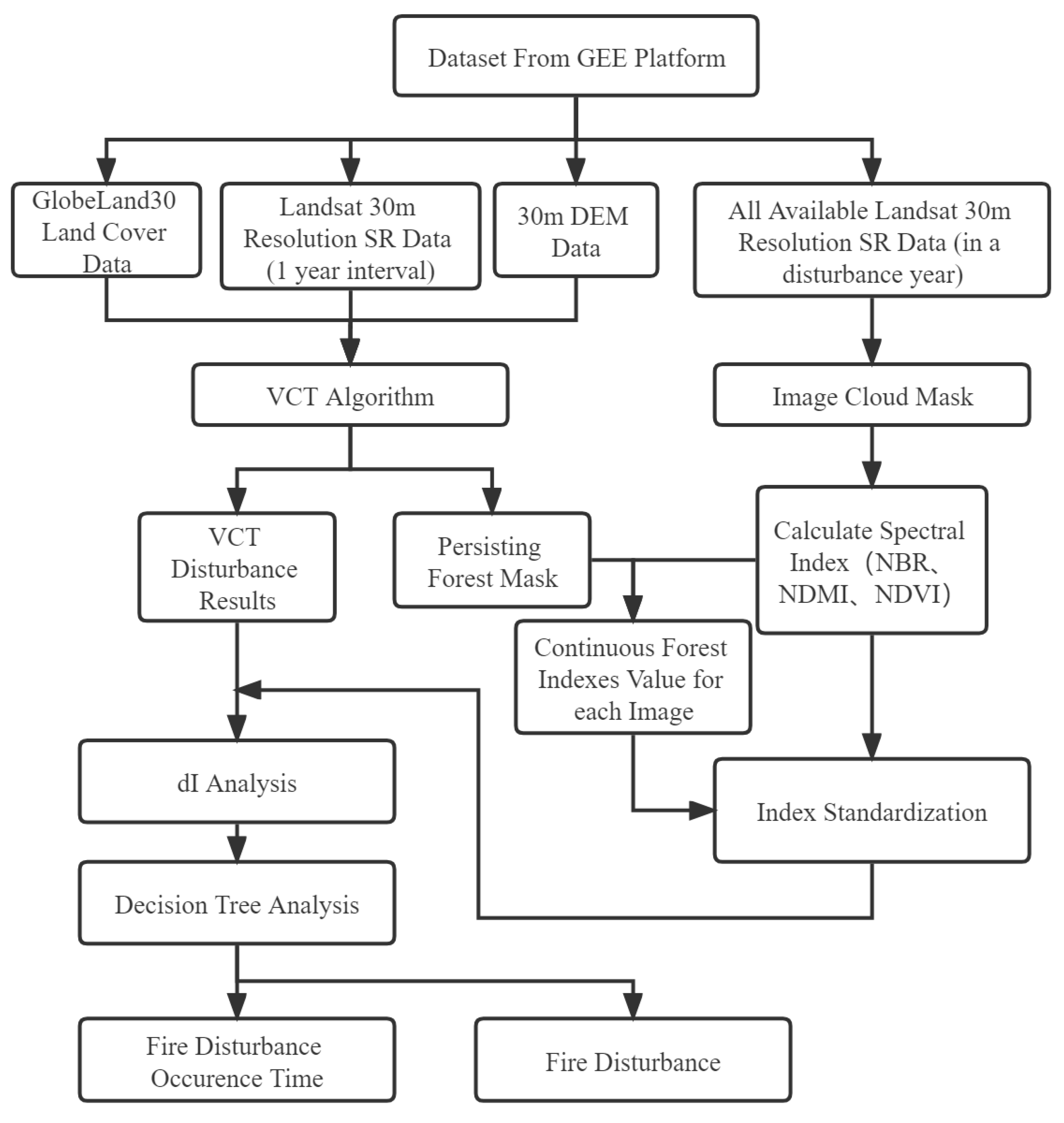
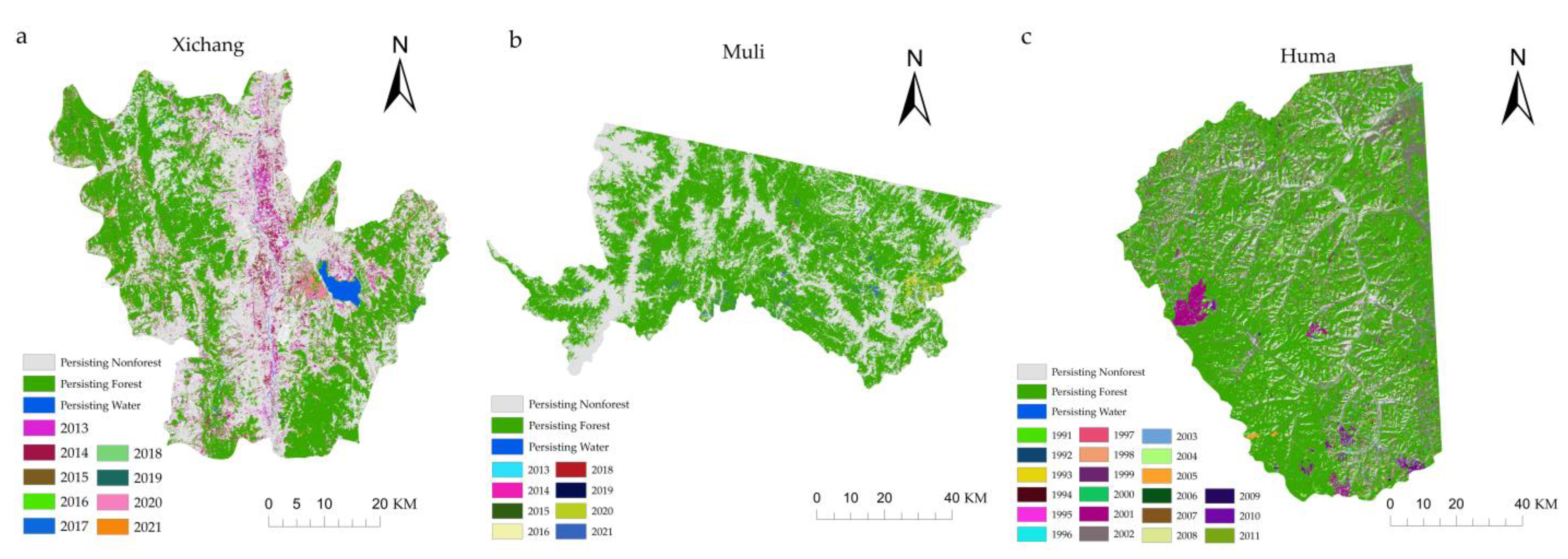
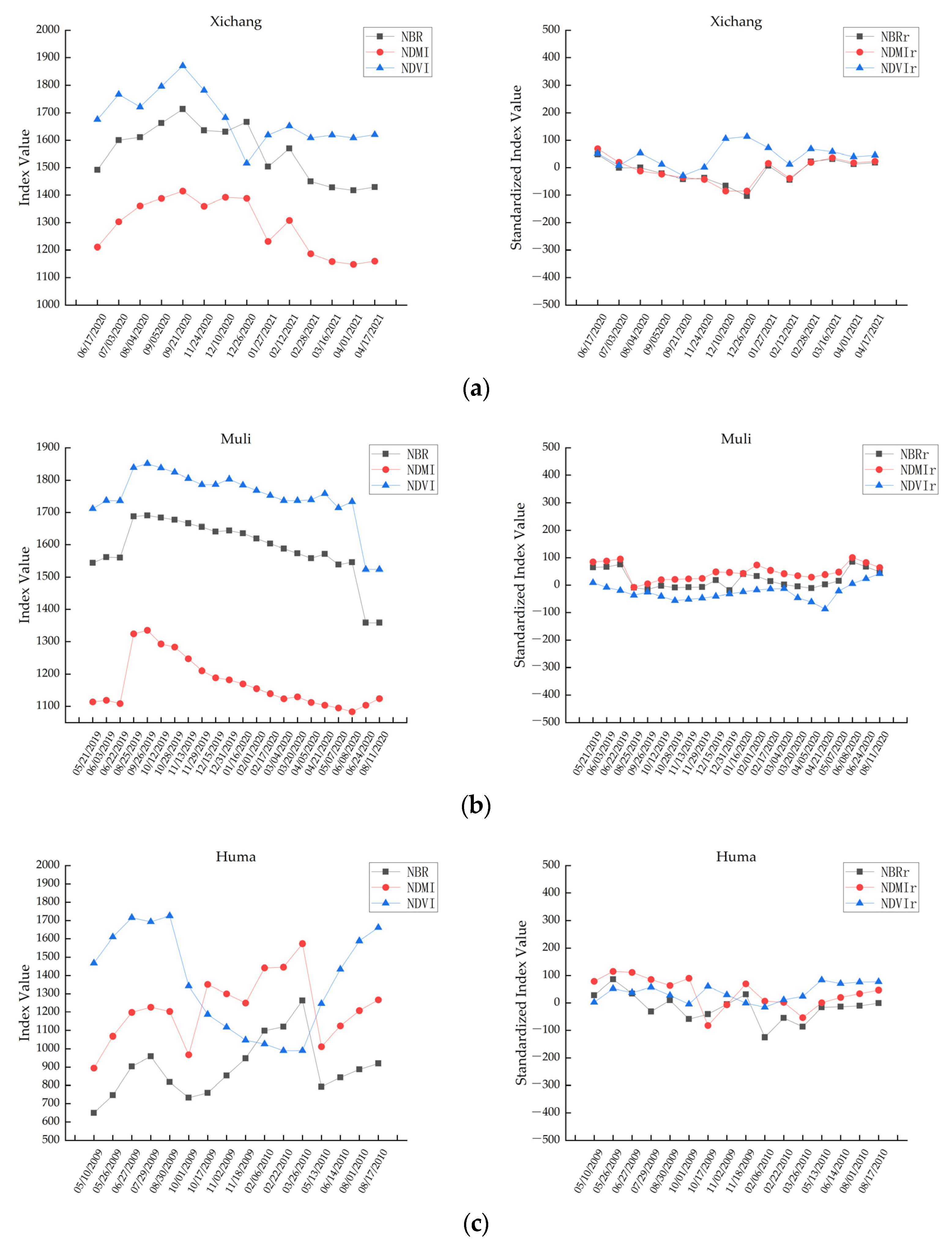


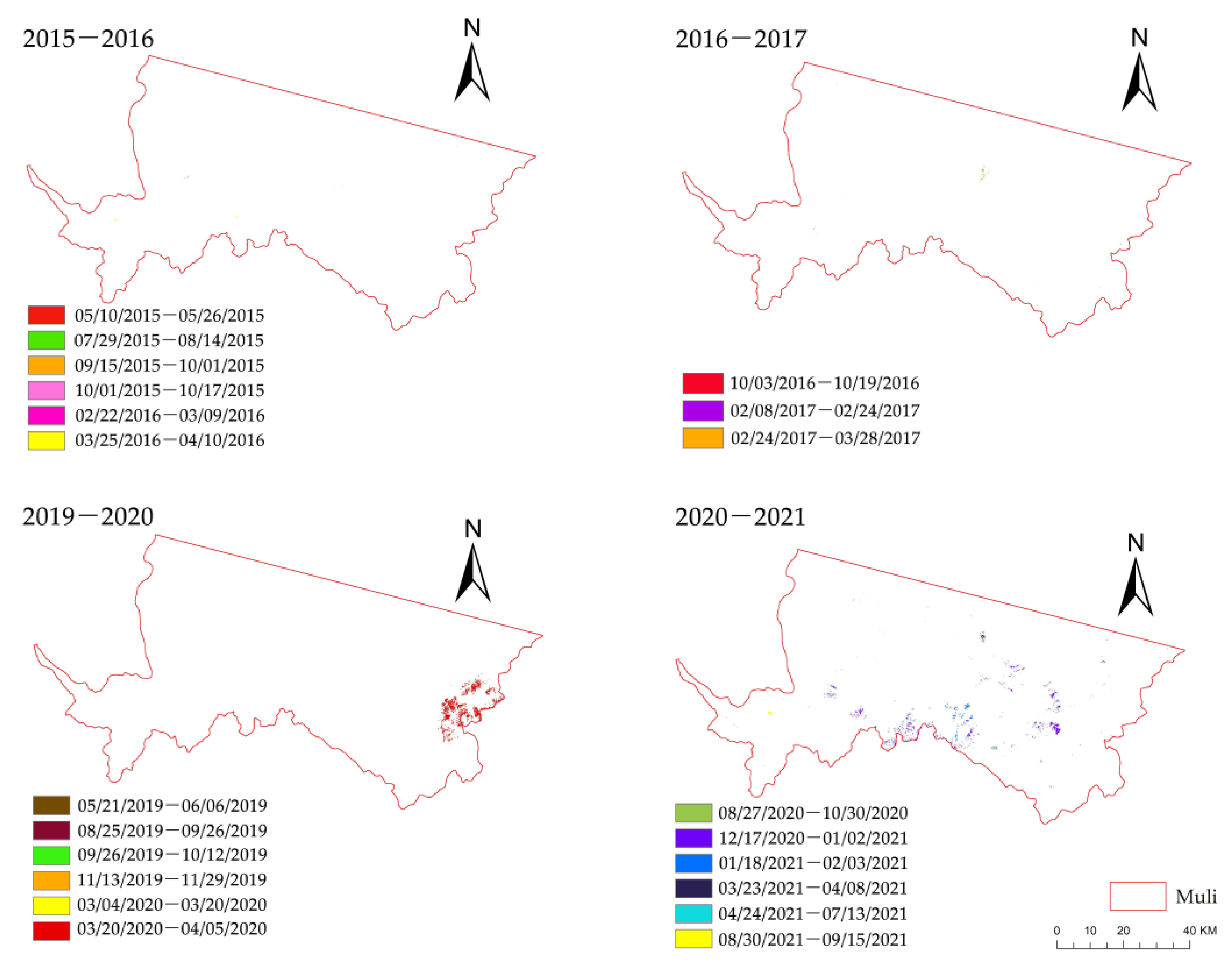


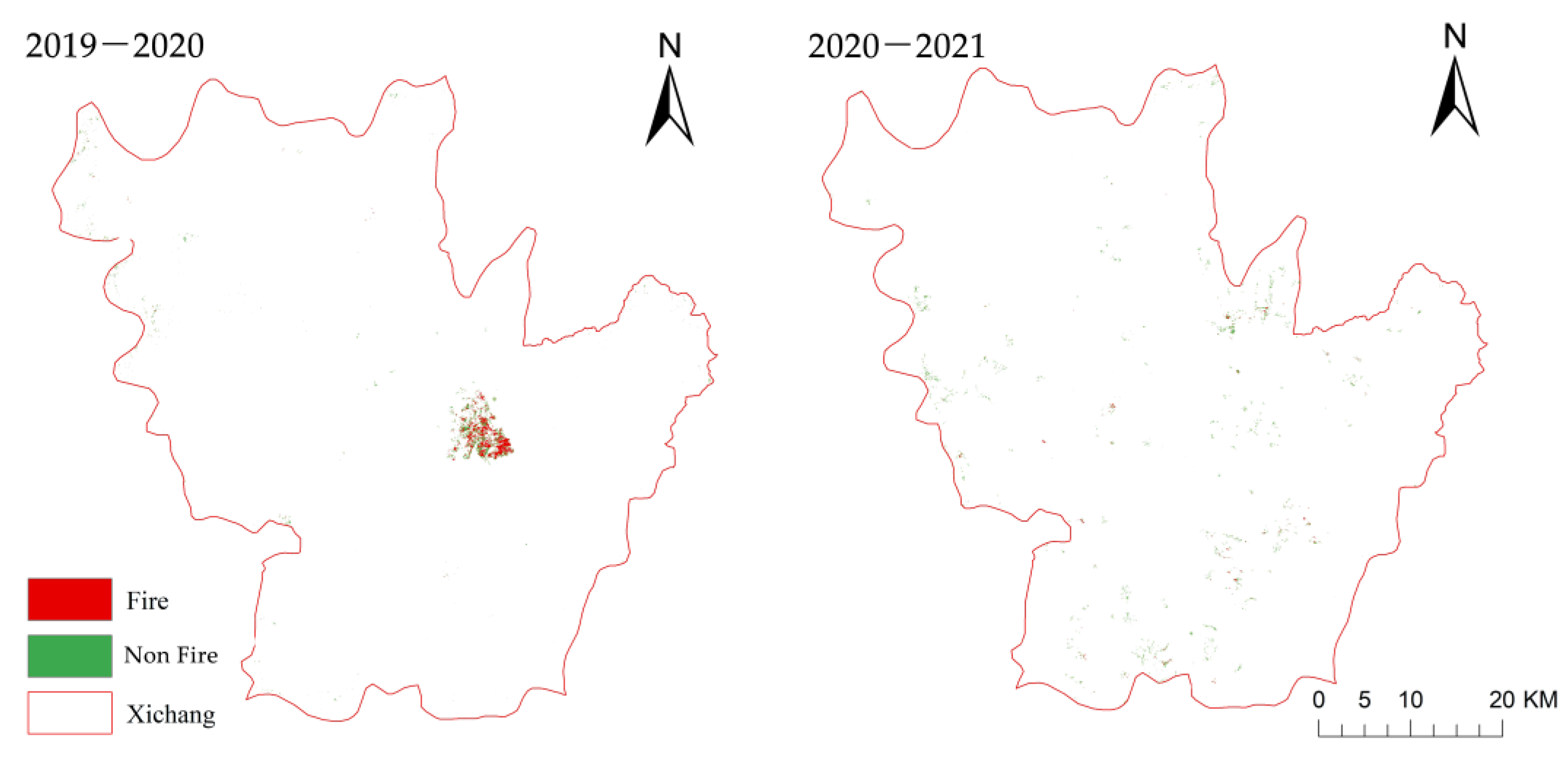

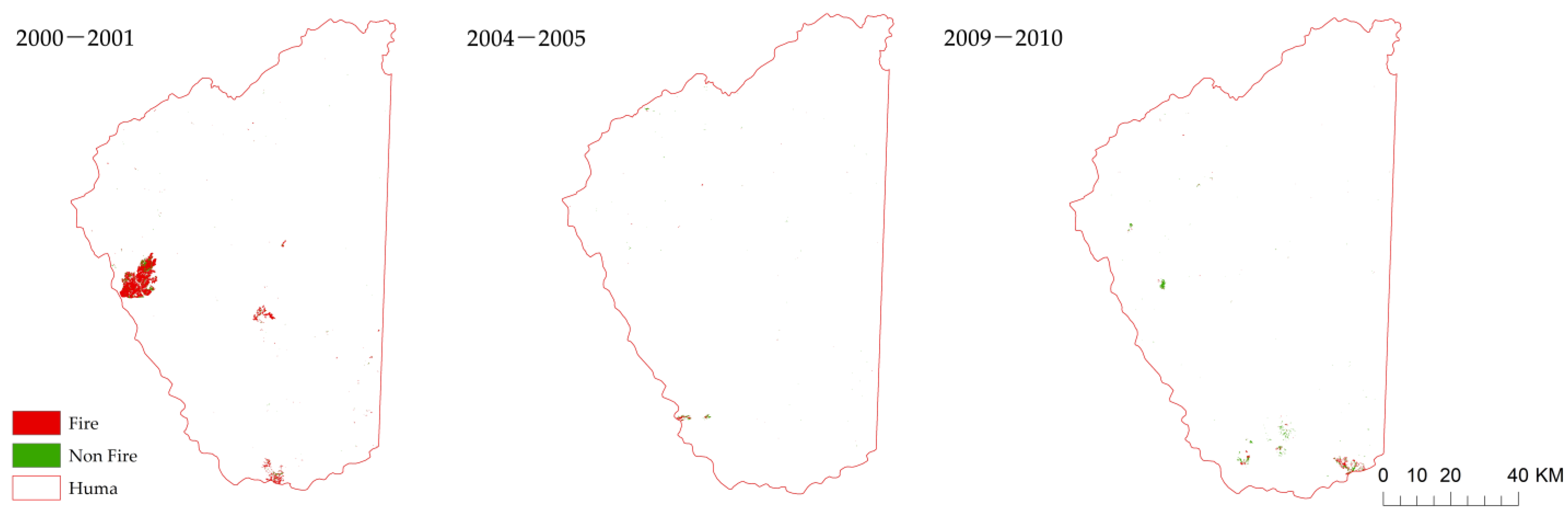
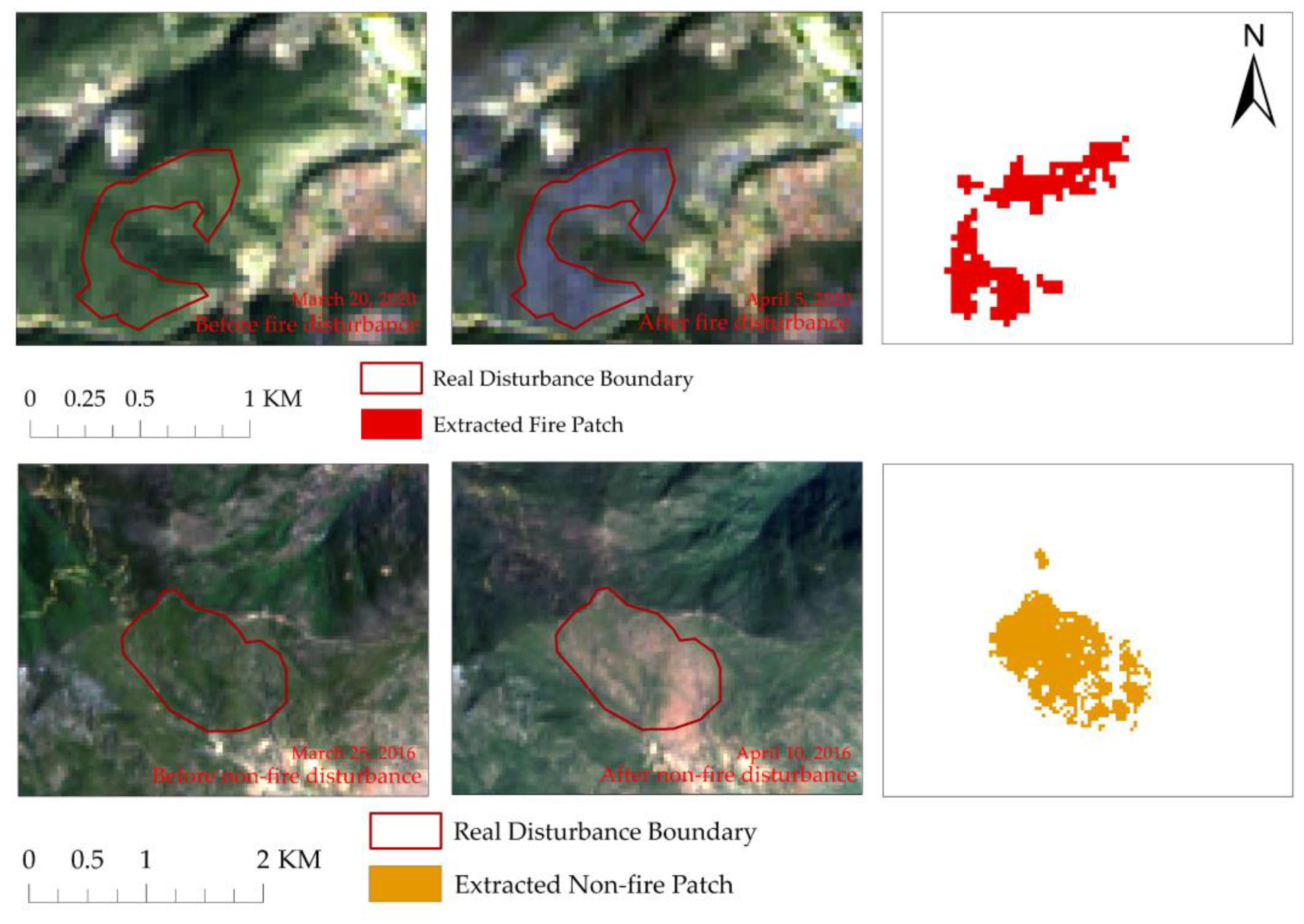
| Area | Path/Row | Sensor | Acquisition Date | Cloud % |
|---|---|---|---|---|
| Xichang | 130/041 | OLI | 14 June 2013 | 0.41% |
| 130/041 | OLI | 10 June 2014 | 3.50% | |
| 130/041 | OLI | 26 October 2015 | 5.35% | |
| 130/041 | OLI | 5 May 2016 | 10.75% | |
| 130/041 | OLI | 9 June 2017 | 21.07% | |
| 130/041 | OLI | 11 May 2018 | 18.36% | |
| 130/041 | OLI | 18 August 2019 | 23.64% | |
| 130/041 | OLI | 1 June 2020 | 47.87% | |
| 130/041 | OLI | 3 May 2021 | 24.38% | |
| Muli | 131/041 | OLI | 11 October 2013 | 0.69% |
| 131/041 | OLI | 28 September 2014 | 7.47% | |
| 131/041 | OLI | 10 May 2015 | 1.27% | |
| 131/041 | OLI | 3 October 2016 | 6.59% | |
| 131/041 | OLI | 25 October 2018 | 0.17% | |
| 131/041 | OLI | 21 May 2019 | 3.60% | |
| 131/041 | OLI | 27 August 2020 | 1.24% | |
| 131/041 | OLI | 2 November 2021 | 2.51% | |
| Huma | 122/024 | TM | 29 August 1991 | 12.00% |
| 122/024 | TM | 15 August 1992 | 16.00% | |
| 122/024 | TM | 18 August 1993 | 8.00% | |
| 122/024 | TM | 4 July 1994 | 2.00% | |
| 122/024 | TM | 11 October 1995 | 0.00% | |
| 122/024 | TM | 10 August 1996 | 0.00% | |
| 122/024 | TM | 29 August 1997 | 0.00% | |
| 122/024 | TM | 16 August 1998 | 1.00% | |
| 122/024 | TM | 2 July 1999 | 0.00% | |
| 122/024 | TM | 20 June 2000 | 0.00% | |
| 122/024 | TM | 24 August 2001 | 0.00% | |
| 122/024 | TM | 28 September 2002 | 3.00% | |
| 122/024 | TM | 11 June 2003 | 4.00% | |
| 122/024 | TM | 13 June 2004 | 1.00% | |
| 122/024 | TM | 2 July 2005 | 6.00% | |
| 122/024 | TM | 5 July 2006 | 0.00% | |
| 122/024 | TM | 24 July 2007 | 22.00% | |
| 122/024 | TM | 28 September 2008 | 1.00% | |
| 122/024 | TM | 1 February 2009 | 1.00% | |
| 122/024 | TM | 2 September 2010 | 3.00% | |
| 122/024 | TM | 3 July 2011 | 1.00% |
| Area | Path/Row | Disturbance Year | Number of Images |
|---|---|---|---|
| Xichang | 130/041 | 2019–2020 | 16 |
| 2020–2021 | 14 | ||
| Muli | 131/041 | 2015–2016 | 20 |
| 2016–2018 | 35 | ||
| 2019–2020 | 21 | ||
| 2020–2021 | 22 | ||
| Huma | 122/024 | 2000–2001 | 17 |
| 2004–2005 | 15 | ||
| 2009–2010 | 16 |
| Path/Row | Disturbance Year | Number of Fire Patches | Number of Non-Fire Patches |
|---|---|---|---|
| 130/041 | 2019–2020 | 1 | 1 |
| 2020–2021 | 0 | 1 | |
| 131/041 | 2015–2016 | 1 | 1 |
| 2016–2018 | 2 | 1 | |
| 2019–2020 | 3 | 0 | |
| 2020–2021 | 2 | 2 | |
| 122/024 | 2000–2001 | 3 | 0 |
| 2004–2005 | 1 | 1 | |
| 2009–2010 | 1 | 4 |
| Area | Disturbance Type | Number of Sample Pixels | ||
|---|---|---|---|---|
| Xichang | Disturbed | Fire | 50 | 100 |
| Non-fire | 50 | |||
| Not disturbed | 100 | |||
| Area | Number of Temporally Matched Pixels | Number of Temporally Mismatched Pixels | Temporal Accuracy |
|---|---|---|---|
| Xichang | 283 | 17 | 94.33% |
| Muli | 271 | 29 | 90.33% |
| Huma | 269 | 31 | 89.67% |
| Reference Data | ||||
|---|---|---|---|---|
| Disturbance Type | Fire | Non-Fire | User’s Accuracy | |
| Fire | 137 | 16 | 89.54% | |
| Non-fire | 28 | 119 | 80.95% | |
| Producer’s Accuracy | 83.03% | 88.15% | Overall | 85.33% |
| Kappa | 0.71 | |||
| Reference Data | ||||
|---|---|---|---|---|
| Disturbance Type | Fire | Non-Fire | User’s Accuracy | |
| Fire | 204 | 15 | 93.15% | |
| Non-fire | 16 | 65 | 80.25% | |
| Producer’s Accuracy | 92.73% | 81.25% | Overall | 89.67% |
| Kappa | 0.74 | |||
| Reference Data | ||||
|---|---|---|---|---|
| Disturbance Type | Fire | Non-Fire | User’s Accuracy | |
| Fire | 153 | 24 | 87.01% | |
| Non-fire | 27 | 96 | 78.89% | |
| Producer’s Accuracy | 85.56% | 80.83% | Overall | 83.67% |
| Kappa | 0.67 | |||
| Area | Year | Fire-Disturbed Area (ha) | Non-Fire-Disturbed Area (ha) | Total Disturbed Area (ha) |
|---|---|---|---|---|
| Xichang | 2019–2020 | 629.64 | 517.23 | 1146.87 |
| 2020–2021 | 56.16 | 274.32 | 330.48 | |
| Muli | 2015–2016 | 19.62 | 52.92 | 72.54 |
| 2016–2017 | 60.75 | 63.99 | 124.74 | |
| 2019–2020 | 3822.75 | 292.86 | 4115.61 | |
| 2020–2021 | 1337 | 2497.41 | 3874.41 | |
| Huma | 2000–2001 | 6866.46 | 522.81 | 7389.27 |
| 2004–2005 | 291.51 | 169.38 | 460.89 | |
| 2009–2010 | 1266.21 | 984.60 | 2250.81 |
Disclaimer/Publisher’s Note: The statements, opinions and data contained in all publications are solely those of the individual author(s) and contributor(s) and not of MDPI and/or the editor(s). MDPI and/or the editor(s) disclaim responsibility for any injury to people or property resulting from any ideas, methods, instructions or products referred to in the content. |
© 2023 by the authors. Licensee MDPI, Basel, Switzerland. This article is an open access article distributed under the terms and conditions of the Creative Commons Attribution (CC BY) license (https://creativecommons.org/licenses/by/4.0/).
Share and Cite
Ye, J.; Wang, N.; Sun, M.; Liu, Q.; Ding, N.; Li, M. A New Method for the Rapid Determination of Fire Disturbance Events Using GEE and the VCT Algorithm—A Case Study in Southwestern and Northeastern China. Remote Sens. 2023, 15, 413. https://doi.org/10.3390/rs15020413
Ye J, Wang N, Sun M, Liu Q, Ding N, Li M. A New Method for the Rapid Determination of Fire Disturbance Events Using GEE and the VCT Algorithm—A Case Study in Southwestern and Northeastern China. Remote Sensing. 2023; 15(2):413. https://doi.org/10.3390/rs15020413
Chicago/Turabian StyleYe, Junhong, Nan Wang, Min Sun, Qinqin Liu, Ning Ding, and Mingshi Li. 2023. "A New Method for the Rapid Determination of Fire Disturbance Events Using GEE and the VCT Algorithm—A Case Study in Southwestern and Northeastern China" Remote Sensing 15, no. 2: 413. https://doi.org/10.3390/rs15020413
APA StyleYe, J., Wang, N., Sun, M., Liu, Q., Ding, N., & Li, M. (2023). A New Method for the Rapid Determination of Fire Disturbance Events Using GEE and the VCT Algorithm—A Case Study in Southwestern and Northeastern China. Remote Sensing, 15(2), 413. https://doi.org/10.3390/rs15020413







